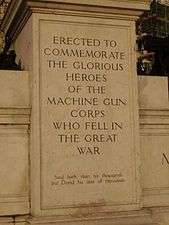Francis Derwent Wood
| Francis Derwent Wood | |
|---|---|
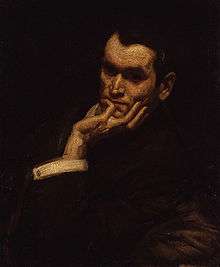 A 1906 portrait of Francis Derwent Wood by George Washington Lambert | |
| Born |
1871 Keswick, England |
| Died |
1926 London, England |
| Nationality | British |
| Occupation | sculptor |
| Spouse(s) | Florence Mary Schmidt (1873–1969) |
Francis Derwent Wood RA (Keswick 1871–1926 London) was a British sculptor.
Biography
Early life
Wood studied in Germany and returned to London in 1887 to work under Édouard Lantéri and Sir Thomas Brock; he taught at the Glasgow School of Art from 1897 through to 1905 and was professor of sculpture at the Royal College of Art from 1918 through to 1923. He was elected to the Royal Academy in 1920. He produced a good deal of architectural sculpture typical of the time, including four large roof figures for the Kelvingrove Art Gallery and Museum in Glasgow, the British Linen Bank also in Glasgow, and the Britannic House in London for architect Sir Edwin Lutyens. Freestanding sculptures by him may also be seen in various galleries, such as his 1907 Atalanta (Manchester Art Gallery,[1] with a bronze cast of it now in Chelsea Embankment Gardens),[2]
World War One
When he was too old (at 41) to enlist in the Army at the onset of World War I, Wood volunteered in the hospital wards and his exposure to the gruesome injuries inflicted by the new war's weapons eventually led him to open a special clinic: the Masks for Facial Disfigurement Department, located in the Third London General Hospital, Wandsworth. Instead of the rubber masks used conventionally, Wood constructed masks of thin metal, sculpted to match the portraits of the men in their pre-war normality. Just as had been happening with soldiers operated upon with the recent advances in plastic surgery, Wood's masks provided each with a renewed self-confidence, even self-respect, though they often proved uncomfortable. Face wounds were known to be the most devastating. By hiding the wounds behind the mask, the young men were able to return to relationships with their families and friends.
Each mask required many weeks of work on the part of Woods, and other surgeons who followed his lead. A plaster cast was taken of the subject's wounded face – but only after the wounds and subsequent surgeries had totally healed. The crude process was itself a trial. The plaster cast was used to make a squeeze of plastocene or clay. This disfigured bust was used as the foundation of all prosthetic restorative work, with the sculptor working to replace the missing components of the face with the shapes from the opposing side. The mask itself was made from a thin copper sheet – galvanized copper to facilitate painting after forming. Painting a realistic portrait onto the copper mask was as challenging as the sculpting: each was finished while the patient wore it, in order to most accurately match the tone of the flesh with the enamels.
The ward stayed open only two years, from 1917 to 1919. There is no record of the exact number of masks made, but it must have been several hundred: a tiny drop among the more than 20,000 wounded in the face. His earnest efforts may not have helped statistically, but they influenced the lives of those he helped dramatically.
Post-war
He produced a representation of The Crucified Soldier called Canada's Golgotha in 1919, which caused a diplomatic flap between the Canadian and German governments. His Machine Gun Corps Memorial at Hyde Park Corner was also controversial.
Personal
He married Florence Mary Schmidt (1873–1969) in early 1903.[3] Wood died in London in 1926 at the age of fifty-five. His grave can be found at St Michael's Church, Amberley, West Sussex with that of his wife.
Works
| Name | Location | Comments | Image |
|---|---|---|---|
| Memorial to Major General Sir John Eardley Wilmot Inglis | St Pauls Cathedral Greater London | Derwent Wood created a relief profile of Inglis which is part of a memorial tablet in the Nelson Chamber of the crypt of St Pauls Cathedral. The memorial comprises a marble wall panel with a bronze medallion portrait of Inglis who sports a large moustache and sidewhiskers. Below is a rectangular bronze panel which depicts an encampment and buildings. The inscription reads "TO THE GLORY OF GOD/ IN MEMORY OF/ MAJOR GENERAL/ SIR JOHN EARDLEY WILMOT INGLIS/ K.C.B./ COLONEL/ OF H.M. 32ND. REG. HE SERVED WITH THAT REGIMENT IN/ CANADA DURING THE REBELLION IN 1837 IN THE PUNJAUB 1848-49/ AT THE BATTLE OF GOOJERAT AND SEIGE AND CAPTURE OF MOOLTAN 1849/ AND DURING THE INDIAN MUTINY OF 1857 COMMANDED THE GARRISON / OF LUCKNOW FOR 87 DAYS AGAINST AN OVERWHELMING FORCE OF THE/ ENEMY HE WAS SON OF THE RIGHT REV JOHN INGLIS BISHOP OF NOVA SCOTIA/ BORN AT HALIFAX NOVEMBER 15TH 1814/ DIED AT HOMBURG GERMANY SEP 27TH 1862/ THE LAST ENEMY THAT SHALL BE DESTROYED IS DEATH. 1 COR.XV 26" inscription on memorial tablet |
|
| Liverpool Cotton Association War Memorial | Liverpool Merseyside | This memorial is located in the Cotton Exchange Building in Liverpool's Old Hall Street. Derwent Wood's bronze figure of a soldier stands on a plinth and a metal plaque is inscribed "THIS MEMORIAL/ WAS UNVEILED BY/ FIELD-MARSHAL/ EARL HAIG/ OF BEMERSYDE/ 5TH APRIL 1922" Inscription whilst a second plaque reads "THIS PLAQUE RECORDS THE NAMES OF THOSE MEN WHO/ WENT FROM THE LIVERPOOL COTTON ASSOCIATION TO THE/ GREAT WAR 1914–1918 AND TO THE WORLD WAR 1939-1945/ AND DIED FOR THEIR COUNTRY IN DEFENCE OF/ LIBERTY AND JUSTICE" inscription and there is then as framed Illuminated Roll of Honour inscribed "THE NAMES HERE RECORDED ARE OF THOSE MEN WHO WENT FROM/ THE LIVERPOOL COTTON ASSOCIATION/ TO THE GREAT WAR 1914-1918/ AND DIED FOR THEIR COUNTRY IN/ DEFENCE OF LIBERTY AND JUSTICE/ 1914-1918/ (NAMES)/ 1939-1945/ (NAMES)" inscription . 358 men perished in the First World War and 65 men in the Second World War.[5] |
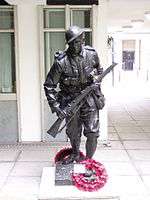 |
| Statue of General James Wolfe | Westerham Kent | Derwent Wood was responsible for the statue of Wolfe on Westerham's Green. Wolfe who died at Quebec in 1759 was born in Westerham.[6] |  |
| Machine Gun Corps Memorial | Hyde Park Corner Greater London | Derwood Wood carried out the sculptural work for the Machine Gun Memorial including the figure of David. The inscription on the front reads "ERECTED TO /COMMEMORATE/ THE GLORIOUS/ HEROES/ OF THE MACHINE GUN/ CORPS/ WHO FELL IN THE GREAT WAR" inscription and another at the memorial's side reads "THE MACHINE GUN CORPS./ OF WHICH HIS MAJESTY KING/ GEORGE V WAS COLONEL-IN-/ CHIEF WAS FORMED BY THE WARRANT DATED THE 14TH DAY/ OF OCTOBER 1915./ THE CORPS SERVED IN/ FRANCE, FLANDERS, RUSSIA, ITALY,/ EGYPT, PALESTINE, MESOPOTAMIA,/ SALONICA. INDIA. AFGANISTAN/ AND EAST AFRICA./ THE LAST UNIT OF THE CORPS/ TO BE DISBANDED WAS THE/ DEPOT AT SHORNCLIFFE ON THE/ 15TH DAY OF JULY 1922. THE/ TOTAL NUMBER WHO SERVED IN/ THE CORPS WAS SOME 11,500/ OFFICERS AND 159,000 OTHER/ RANKS OF WHOM 1,120 OFFICERS/ AND 1,671 OTHER RANKS WERE/ KILLED AND 2881 OFFICERS AND /45377 OTHER RANKS WERE WOUNDED, MISSING OR PRISONERS/ OF WAR" inscription |
 |
Images of Machine Gun Corps Memorial
Further works
| Name | Location | Comments | Image |
|---|---|---|---|
| Kelvingrove Art Gallery and Museum. | Kelvingrove | In 1898 Derwent Wood was one of the four sculptors chosen in competition to produce a series of sculptures for the Kelvingrove Art Gallery and Museum in Glasgow. The building has four large Derwent Wood sculptures on the roof and over the small tower on the left of the main entrance. The first is called Music and features a woman playing a violin, the second, called Architecture involves a woman holding a tapered column. The tower on the right has the sculpture Painting, with a woman in classical pose holding brushes, palette and a painting, and Sculpture featuring a woman holding a mason’s hammer and a statuette.[8] | |
| The Penitent Thief | Port Sunlight Merseyside | This 1918 work by Derwent Wood can be seen in the Lady Lever Art Gallery at Port Sunlight. The head is of one of the two thieves crucified alongside Jesus Christ.[9] | 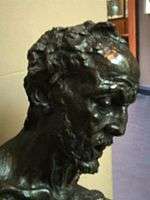 |
| Statue of Atalanta | Chelsea Embankment Greater London | The original work "Atalanta" by Derwent Wood was in marble and dates to 1909 and after his death various friends of Derwent Wood including members of the Chelsea Art Club had a cast of the work made in bronze and it stands by the Chelsea Embankment. The original marble statue is held by the Manchester Art Gallery.[10] | |
| Psyche | Port Sunlight Merseyside | This green bronze dates to 1920 and is in the Lady Lever Art Gallery. Regarded as a good example of the "New Sculpture" movement.[11] | |
| Indian Water Carrier | Finsbury Circus Greater London | Britannic House was designed by Sir.E.L. Lutyens for the Anglo-Persian Oil Company, which later became British Petroleum. There are several sculptures positioned around the exterior of this building and Derwent Wood was the artist who created the Indian Water Carrier.[12] | |
| Britannia Persian Scarf Dancer | Finsbury Circus Greater London | For the same building, Britannic House, Derwent Wood carved the two figure of Britannia and the Persian Scarf Dancer which adorn the exterior. He was also responsible for the Woman with baby on the same building.[13] |  |
| Statue of Sir F.H. Royce | Derby Derbyshire | Derwent Wood was responsible for the statue of Sir Frederick Henry Royce.[14] |  |
| British Linen Company Bank | Glasgow | Derwent Wood modelled the figures of the Ship's Prow and Zephyrs which adorn this building in Govan Road, Glasgow.[15] | |
| "Australia" | Buckingham Palace Greater London | Derwent Wood was commissioned to sculpt the figure to represent Australia which is located on the east side of the Mall Circus in front of Buckingham Palace and the Victoria Monument. This work is dated 1920. Derwent Wood includes a kangaroo, some grapes and wool as well as the Australian Coat of Arms.[16] | 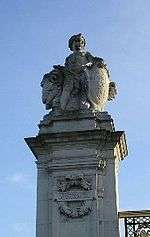 |
| Statue of Sir Titus Salt | Saltaire Yorkshire | Derwent Wood was responsible for this 1903 statue of the Bradford mill-owner.[17] | 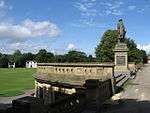 |
| Ditchingham War Memorial | Ditchingham Norfolk | [18] | |
| Keswick War Memorial. | Keswick Cumbria | Derwent Wood was the sculptor of the relief depicting "Victory" in classical costume with sword on the front face of the cenotaph.[19] |  |
| Humanity Overcoming War | Cartwright Hall, Bradford West Yorkshire | 1921[20] | |
Other images
- Francis Derwent Wood's Machine Gun Corps Memorial World War I memorials in London, England
- Francis Derwent Wood's Machine Gun Corps Memorial at Hyde Park Corner
 Francis Derwent Wood's Atalanta (credited as "Chelsea Embankment statue"), London, England
Francis Derwent Wood's Atalanta (credited as "Chelsea Embankment statue"), London, England
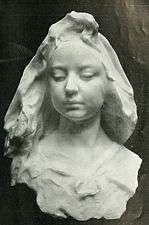 Francis Derwent Wood's Maggie.
Francis Derwent Wood's Maggie.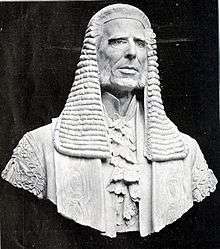 Francis Derwent Wood's Lord Henn-Collins
Francis Derwent Wood's Lord Henn-Collins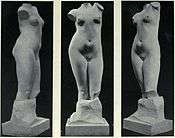 Francis Derwent Wood's female nude
Francis Derwent Wood's female nude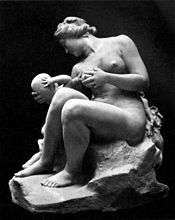 Francis Derwent Wood's Abondance
Francis Derwent Wood's Abondance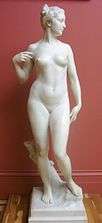 Francis Derwent Wood's Atalanta
Francis Derwent Wood's Atalanta- Francis Derwent Wood's Atalanta
 Francis Derwent Wood's Leda and the Swan
Francis Derwent Wood's Leda and the Swan Francis Derwent Wood's Female nude
Francis Derwent Wood's Female nude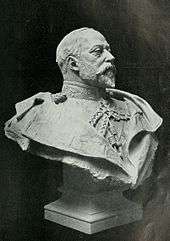 Francis Derwent Wood's Edward VII
Francis Derwent Wood's Edward VII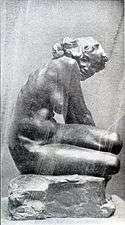 Francis Derwent Wood's La Baigneuse
Francis Derwent Wood's La Baigneuse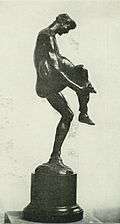 Francis Derwent Wood's Faune et outre
Francis Derwent Wood's Faune et outre
References and notes
- ↑ http://www.manchestergalleries.org/the-collections/search-the-collection/display.php?EMUSESSID=c0c2555eaedb9f99ee343e1f3834b993&irn=1194
- ↑ http://yourarchives.nationalarchives.gov.uk/index.php?title=Wood%2C_Francis_Derwent_(1871-1926)_sculptor
- ↑ "Index entry". FreeBMD (Paddington registration district). ONS. Retrieved 7 September 2014.
- ↑ Maj Gen Sir J E W Inglis UKNIWM. Retrieved 22 November 2012
- ↑ Liverpool Cotton Association War Memorial UKNIWM. Retrieved 22 November 2012
- ↑ Statue of General James Wolfe UKNIWM. Retrieved 22 November 2012
- ↑ Machine Gun Corps Memorial UKNIWM. Retrieved 22 November 2012
- ↑ Kelvingrove Art Gallery and Museum Glasgow Sculpture. Retrieved 23 November 2012
- ↑ The Penitent Thief Liverpool Museums/Lady Lever Art Gallery. Retrieved 23 November 2012
- ↑ Statue of Atalanta Tired of London tired of life. Retrieved 23 November 2012
- ↑ Psyche The Victorian Web. Retrieved 23 November 2012
- ↑ Indian Water Carrier The Victorian Web. Retrieved 23 November 2012
- ↑ [ ] The Victorian Web. Retrieved 23 November 2012
- ↑ Statue of Sir F.H. Royce Rolls Royce Website. Retrieved 23 November 2012
- ↑ British Linen Company Bank sculptures Glasgow Sculpture. Retrieved 23 November 2012
- ↑ Australia The Victorian Web. 23 November 2012
- ↑ Statue of Sir Titus Salt The Victorian Web. Retrieved 23 November 2012
- ↑ Ditchingham War Memorial Norfolk Churches. Retrieved 23 November 2012
- ↑ Keswick War Memorial UKNIWM. Retrieved 23 November 2012
- ↑ http://www.bradfordmuseums.org/whatson/event_detail.php?ID=593
| Wikimedia Commons has media related to Francis Derwent Wood. |
External links
- Smithsonian Magazine article, February 2007
- National Public Radio story, February, 2007
- Project Façade's page on Wood
- Gillies Archives, Queen Mary's Hospital, Sidcup UK
- Francis Derwent Wood Article on The National Archives website which deals with some of Derwent Woods' work.
- Suzannah Biernoff, ‘The Rhetoric of Disfigurement in First World War Britain,’ Social History of Medicine (Feb. 2011).


